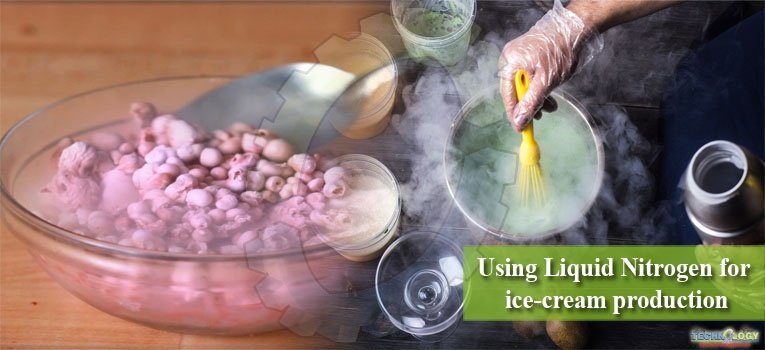Like every other person on earth, you may have eaten hundreds or even thousands of ice-cream scoops, not only in summers but in winters too.

Ever wondered how ice-cream is produced or made and what maybe the ingredients involved? What about the new ingredient being used in ice cream production for the speedy manufacture of this yummylicious desert; liquid nitrogen.
Ice cream production:
The creation of ice cream does not seem complicated; but in contrast to one’s belief of just freezing the ingredient is not true. However, the fabrication of ice cream requires the slow ice crystal formation allowing it to form a creamy texture.
This freezing process can be long and time-taking, so there is one secret ingredient that chefs or ice cream makers use for time-saving and that is Liquid Nitrogen.
Liquid Nitrogen:
Liquid Nitrogen is a colorless liquid that boils at very low temperature, -195.790C to be more precise. Above this temperature the chemical exist as a gas, while if placed below this temperature, it exist as a liquid and is thus stored and transported in vacuum flasks.
Liquid nitrogen can cause rapid freezing when it comes in contact with living tissues, thus is used for the rapid crystallization of the ice cream mixture.
Mechanism of action of Liquid Nitrogen:
The ice cream base mixture, usually consisting of sugar and heavy cream, is mixed with an appropriate amount of liquid nitrogen. As soon as the liquid nitrogen, with a temperature of -195.79oC is poured onto the mixture, it causes the production of small ice crystals, almost the size of seeds.
After pouring liquid nitrogen into the ice cream mixture, it is stirred and the mechanical energy from the motion causes the newly formed crystals to further break up into smaller pieces.
The crystals in the final ice cream product are never felt by our taste buds because they are less than 20 micro-meter, and are unable to be felt by the sensors of our mouth.
If the mixture is not stirred rapidly, it will result in the formation of large crystals and will have a coarse effect on the final ice cream mixture.
In contrast to using liquid nitrogen in the ice cream formation, the normal freezer does not exert an outside force during the crystal formation (as does stirring) and thus the crystals continue to become larger and larger, with the final product being coarse and rough.
Other uses of Liquid Nitrogen:
The use of liquid nitrogen for preservation is not new. In many laboratories and industries, it is used for the save conservation and maintenance of living tissues and cells.
Apart from that, liquid nitrogen is being used in Cryo-cooking; in which the food product is freeze using the liquid nitrogen and then fried to maintain the appropriate texture of the product being made.
It may also be used for the conversion of fresh herbs into powdered form, by dipping the herbs into liquid nitrogen and then crushing them.
Safety First!!
As long as the safety of ice cream is concerned regarding human consumption, it has been reported that after its production from liquid nitrogen, ice cream is stored at -40oC before it may be sold or served to costumers. And at that temperature, ice cream is absolutely safe for human eating.
As discussed earlier, the temperature of liquid nitrogen is -195.79OC, so this chemical should be handled with care and suitable equipment. The operator should wear safety gloves and eye-wear to protect himself from any damage. The contact of liquid nitrogen with the living tissues of the body may result in severe frost bite.